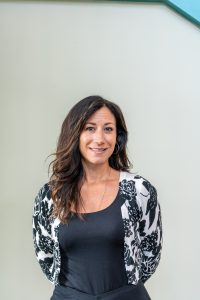The Goodwin community isn’t just about education; our faculty and staff commit themselves to inclusivity and growth by enhancing their practice as instructors and professionals — fostering accessible, student-centered educational environments that meet the needs of diverse learners.
Devoted to redefining higher education, Goodwin embraces Universal Design for Learning (UDL). Rooted in research, this framework champions equal access for all learners. But here’s where Goodwin excels: at our University, we don’t just introduce UDL as a concept; we empower our faculty with applicable skills and strategies through our Advanced UDL (AdUDL) Institute. Here, they master UDL principles, ensuring every student gets the equitable, effective education they deserve.
Our most recent cohort at the AdUDL Institute included Dr. Liz Lane, Dr. Vita A. Vernace, Professor Vinod Dhar, Professor Parth M. Desai, Professor Lisa Fanelli, and Dr. Jayanti Roy. Read and discover how UDL has helped them create inclusive learning environments optimal for unique learners.
Guiding the Guiding Questions
By Dr. Liz Lane

Recently, I had the meaningful opportunity to take a deep dive through the lens of UDL into the use of guiding questions in English 101 at Goodwin University. Through appreciative inquiry, I wanted to explore guiding questions as a teaching tool. Moreover, I sought to understand the role these types of questions have from the perspective of UDL principles and checkpoints, as well as the current use of this instructional technique as part of my practice.
Understanding and navigating guiding questions
With no clear starting point, I jumped in utilizing a funneling technique for the inquiry — first looking to define a guiding question, its structure, and purpose, then narrowing the focus to the specific guiding questions in English 101.
So, what are guiding questions? According to the Association for Supervision and Curriculum Development (2022), a guiding question is a question that encourages students to engage with the topic, personalize the material, and apply the ideas beyond what might be simple memorization. It is important to note that there is a markedly different design to guiding questions versus, for example, leading questions or questions with clear correct (or incorrect) responses. Ideally, guiding questions influence students’ engagement by activating prior knowledge and moving learning experiences beyond merely transactional events.

When evaluating the English 101 course modules for the presence and quality of guiding questions, the inquiry revealed that the current questions ask students to consider opinions they already hold and provide an opportunity to expand that understanding. This feature of the guiding question design reflects the UDL guideline for Representation — Checkpoint: 3.1 (highlighting the usefulness of activating background knowledge for learners). Although this finding was great, there was some work to be done!
Increasing student engagement
Upon further examination, I found the placement and purpose of the guiding questions could potentially be unclear to students. Guiding questions help focus inquiry and provide an entry point into the material; however, they can also be another means of further reflection for students as they expand their understanding of content throughout a module.
But do students even know what to do with the guiding questions? Should they simply think about them? Should they write down their responses and share them with peers? It occurred to me that providing some guidance to the guiding questions would be beneficial. I thought about it this way; if I were a tour guide, would I leave my guests at the door of the Louvre, or would I accompany them through the museum to help them make the most of the experience?

Informed by the UDL guideline for Action and Expression — Checkpoint 6.4, which stresses the importance of students monitoring their progress, I modified the location and structure of the guiding questions for consistency and placed some simple but detailed instructions — now encouraging students to revisit their responses to the guiding questions throughout the module and share their evolving perspectives with peers on the discussion board. These changes brought clarity and meaning to the guiding questions for me, and I believe the 101 students will have similar experiences.
Opening new doors to learning
Engaging in questioning as a strategy for opening doors to ideas (and prompting learner reflection) is a natural, widely used approach firmly established in neuroscience research. Looking outside of formal education, parents and caregivers ask questions of their children regularly. As the mom of a highly inquisitive 13-year-old girl, I always respond to her questions with questions. The goal is to prompt her critical thinking. “What are the potential outcomes if you do ABC?” “Have you considered other perspectives?” While we might end up heading straight down an unpredictable rabbit hole, those winding turns energize thinking and unlock new ideas — and isn’t that just what educators are trying to accomplish with students every day in classrooms across the world?

So, as one more invaluable tool in the toolbox, guiding questions can be part of an effective UDL teaching strategy — honoring students’ unique experiences while inviting their curiosity to learn more.
References
Association for Supervision and Curriculum Development (2022). What is a good guiding question? https://www.ascd.org/el/articles/what-is-a-good-guiding-question
Using UDL Guidelines to Re-Design an Anatomy and Physiology Course
Dr. Vita A. Vernace, Professor of Science, Director of Natural Sciences, Senior Teaching Fellow

Through my experience in the AdUDL Institute, I wanted to find ways that I could integrate more UDL in the sciences, specifically into the course Anatomy and Physiology 2 (BIO212). Not only did I want to engage the students, but to make education possible for all types of learners.
By participating in the AdUDL Institute, I looked at myself as an educator and a learner. Moreover, with the collaboration of my peers, I was able to gain insights from my colleagues and make the changes that are the most beneficial to the students through my re-design.
Maximizing transfer and generalization
I utilized Checkpoint 3.4, which maximizes transferable knowledge and generalization, quite often during my re-design.
First, I co-created a “Weekly Course Rhythm,” which provided students with a suggested schedule for organizing their time spent reading and watching class content, completing assessments, incorporating time to study, and contacting me for help. In addition, I included hyperlinks to class assessments in the Weekly Course Rhythm schedule.

Secondly, I utilized this checkpoint by revising all lecture and lab quizzes from a maximum of two chances to unlimited attempts. These are low-stakes assessments, and with unlimited attempts, students can take the quizzes as a preassessment before reading or watching the content and then again after — repeating the quizzes until they have mastered the material.
Activating background knowledge
While redesigning my course, I frequently used Checkpoint 3.1 to activate or supply background knowledge.
First, I added a purpose statement and an estimated time to completion on all assessments. By including these two critical pieces of information, students can click on an assessment and see how much time they should budget to complete the task. In addition, they can see the purpose (or the “why”) of the assessment — why are we asking the students to complete these tasks? How and when will we use this assessment? How does this task tie into the course? What are the learning outcomes?

Secondly, I determined all the module overviews were too long and did not capture student attention or engagement. After the redesign, all module overviews now include an attention-grabbing fun fact, an explanation of what is in the module, how the information is related to previous content, and how the module will tie into the next module.
Guiding information
Before joining the AdUDL Institute, I had not included guiding questions in this course.
Quickly, I realized this was a considerate misstep on my behalf. To rectify this, I revised each module to include guiding questions. Including these big-picture questions right before the reading and videos helps students purposefully engage in the learning material. These guiding questions serve as a template while the students work through the content by helping them link prior, current, and upcoming learning materials.
Offering alternatives
Finally, I considered Checkpoint 1.3 to find new ways to make information more accessible to my students.
This summer, we will transition to a new edition of the class textbook. My AdUDL experience created a fantastic opportunity to take the PowerPoints, edit the learning materials to fit our curriculum and use the accessibility checker to ensure the material can be effective for all learners. All images will now have alt tags to aid in accessibility. Furthermore, I assessed all the reading orders to guarantee that screen readers are accurate. In doing so, I’ve proactively removed barriers so all students can access the content for the course.

The driving force behind all these changes was to remove barriers and ensure that every learner could gain the knowledge they need to succeed. I have learned so much from my colleagues at the AdUDL Institute, and I’m excited to share the re-design with my peers — and most importantly, my students!
Applying UDL to Chemistry 101
Vinod Dhar, Curriculum Director of Chemistry and Professor of Science

Chemistry 101 is a survey of general, organic, and biological chemistry designed for individuals pursuing careers in health-related professions. As faculty, we try our best to provide resources and engage students in meaningful ways, giving them multiple options to increase their understanding of critical subject matter that they can apply throughout their program of studies.
Advanced UDL elevates student learning to a new level as instructors customize more appropriate content and provide tools for navigating the material. Students appreciate having the autonomy to use multiple resources. My goal is for every student to develop a thorough understanding of the content, and by incorporating the latest research articles and real-life examples into coursework, I strive to make classes more holistic and engaging.

Lectures within the UDL framework involve meaningful discussions, participation, and problem-solving — all of which enhance students’ critical thinking and overall understanding of the subject. Since this course includes a laboratory component, learning materials should help students develop clear concepts they can apply to experiments. Adopting a more visual, hands-on approach enhances their retention of the material.
I have been fortunate to work under the leadership of Dean Diana LaRocco, senior faculty member Annjanette Bennar, and many other valued team members. This cohort would not have seen the light of the day without their dedication to Goodwin and enormous support!
At Goodwin, we start with you. Our career-focused, student-centered programs are designed with your needs in mind. With comprehensive support services, flexible scheduling, and expert faculty guidance, Goodwin will help prepare you for the future you deserve. Learn more about joining the Goodwin community today!
Expanding Horizons, Embracing Learning Differences
Parth M. Desai, OTD, OTR/L, MCMT, Occupational Therapy Assistant (OTA) Program Director

Mahatma Gandhi once said, “Be the change you wish to see in the world.” In reading this quote, I wanted to help foster change by removing barriers to optimal learning for our students at Goodwin University and higher education in general. After being accepted to the second cohort of the Advanced UDL Institute, I decided to analyze how my course in the Occupational Therapy Assistant (OTA) program, OTA 218— Case Studies Across the Lifespan, could be enhanced using appreciative inquiry.
Reviewing the course content, I immediately encountered a few modules that already implemented UDL principles. However, the focus on maximizing engagement, highlighting representation, and including action and expression was sub-optimal. Through imaginative and innovative thinking, I knew I could expand the horizons of student understanding and learning to provide them with the highest level of education.
To remove barriers to student learning, the first concept I embraced was that each student, regardless of age, gender, or previous knowledge, learns differently. I believe essential and ideal learning occurs when we combine student motivation and instructional style with a proper course design. My focus for this course used a staircase image that showed gradual progress from changing the previous course shell of OTA 218 to using minimal basic UDL principles — creating a robust shell with proper utilization of principles learned in the Advanced UDL Institute. The concept of the three Ls — layout, lecture, and learning — would be supported by the activities and assessments implemented in this course.

Addressing the Ls
The current curriculum lacked an initial focus point for the students, who often wrestle to attend class on time each evening due to combatting personal and work commitments. Without proper direction, course materials could cause additional threats and distractions, which could further limit barriers to learning.
After reviewing this issue from the lens of UDL, I am now supporting student learning through specific guiding questions and anecdotal reflections to maximize their transfer of learning and understanding. This strategy is supported by Checkpoint 7.3 – Minimizing threats and distractions, and Checkpoint 1.1 – Offering ways of customizing the display of information. Furthermore, I increased the accessibility of these guiding questions by highlighting them and intentionally spacing each throughout the modules- allowing easier access and focal points to keep students engaged and motivated.
The second “L” focused on optimizing the course syllabus to add an agenda for every class so students clearly understood each week’s key lecture topics. To address this, topics and in-class activities will now be listed in each module via a visually appealing timeline table.
I made this revision considering Checkpoint 3.3 – Guiding information processing and visualization, which removes the barrier of not knowing what the lecture will entail. Earlier awareness of lecture material and role-play/active learning activities help students better prepare. Once again, Checkpoint 1.1 was used for support, as each agenda is customized using language and images that are easy to understand and aid in preparation.

The final “L” consisted of changes in specific learning activities and assignments, which I enhanced within the OTA 218 course. I wanted to embrace and include the learned UDL concept of Interactive Teaching.
The first newly designed activity is a Quiz Debrief, allowing students to master key concepts within our course. The instructor facilitates a thought-provoking discussion to improve student learning as students, dividing them into groups after completing a quiz individually. Then, students collaborate to review incorrect responses and determine why the correct answer is more accurate. This exercise facilitates student understanding; they work to identify supporting materials from textbooks, lecture slides, and more–ensuring their comprehension while incentivizing them with the opportunity to achieve up to ½ credit for each incorrect answer they revise.
The incentive to better their grade through this created activity improves their understanding of critical concepts while preparing them to transition from dedicated students to robust, competent clinicians. This change is supported by UDL Checkpoint 4.1 – Varying the methods of response and navigation.
Amending assignments
Another learning activity I changed in OTA 218 is the final assignment, “Adding to Your Toolkit.” The existing blueprint of the assignment asked students to produce four different deliverables. This vintage request created heavy cognitive and physical overload for students already preparing for final assessments in many other classes.
To reduce the barrier and thereby improve the learning environment, I referred to Checkpoint 6.2 – Support planning and strategy development. Scaffolding the assignment by spreading the deliverable due dates throughout multiple weeks will limit barriers while enabling students to receive consistent feedback. Through constant discussion and tailored feedback, the student-instructor relationship is strengthened and nurtured — helping students create high-yield final projects.

The final assignment created with UDL principles is the “Minute 2 Win It – Activity Analysis” assignment. Activity analysis is a pivotal concept within the OTA program, especially in this course. Students must regularly determine the sequence, process, steps, and other components of specific activities. While case study videos and examples are beneficial, this newly created assignment allows students to engage in fun, competitive, and purposeful activities adaptable to clinical interventions they will use in their careers.
For this new assignment, student learning is scaffolded with a visual checklist tool, which asks them to answer important questions regarding activity analysis and other core OTA topics while participating in the games. This assignment is supported by UDL Checkpoint 5.2 – Use multiple tools for construction and composition, which encourages participation in enjoyable learning activities designed to boost focus and engagement.
Overall, it was an honor and a true pleasure to be selected to participate as a member of the second cohort of the Advanced UDL Institute. More learning is obtainable for instructors as we continuously maximize student learning outcomes within higher education. We hope today is one step closer to expanding the horizons of student learning within higher education.
Purposeful Transparency: A UDL Journey to Add Purpose and Connection to a Leadership in Healthcare Course
Lisa Fanelli, OTD, Associate Professor and Director of the Health Science and Public Health programs

An opportunity to add UDL strategies and enhance existing ones in a Public Health Leadership in Healthcare course (PBH 301) was an exciting challenge to accept as a member of the second cohort in the Advanced UDL Teaching Fellowship at Goodwin University.
As I completed a comprehensive scan of this course, I appreciated the UDL aspects already embedded throughout. However, I quickly realized that by working at a more deliberate and precise UDL checkpoint level, I could make vast improvements to PBH 301. Through the appreciative inquiry process, I identified a few learning barrier themes within the Leadership course. These barriers included a lack of purpose statements for assignments, which correlates to a void in transparent communication, highlighting the congruency between learned materials and deliverable work (Nave, 2021). Similarly, there was a lack of knowledge transfer between modules from previously learned content, which may have resulted from transitioning to an Open Educational Resource (OER) course.
Last year, I revised the PBH 301 course by adopting an Open Educational Resource platform and removing any textbooks from the required materials. During this revision process, I also implemented a few +1 UDL strategies, which have made a tremendous difference in student engagement during this 15-week online asynchronous course.

One significant change resulting in increased student engagement and accountability was the options to read, watch, and listen to content. Through this variation in methods for response and navigation (UDL Checkpoint 4.1,) students record themselves weekly in Canvas Studio responding to a “funny” meme and explaining how it relates to the module’s content about leadership. Then, they must identify three facts from the readings, podcasts, and videos to explain how they perceive the applicability of each concept in their professional environment.
I also recorded 2-3-minute videos for each assignment, thoroughly reviewing the directions, rubric, and expectations. These videos enable transparency through a learner-centered lens by providing accessibility and minimizing threats in completing each assignment (UDL Checkpoint 7.3).
Providing purposeful options for comprehension
The examination of UDL fidelity throughout PBH 301 yielded common themes — with purpose and transparency at the top of the list. The assignments and deliverables are creative, unique, and aligned with certain aspects of accessibility. However, building the content, internalizing where the learning material will reside, and my aim to develop learners could benefit from a deeper dive into the recognition network checkpoints.

By activating and supplying background knowledge by including a purpose statement for each assignment (Checkpoint 3.1), I can provide the learner with a curricular alignment of how this assignment supports the overall course learning objectives. With multiple opportunities to introspectively review PBH 301 during the Fellowship, I was reminded that students not only need the objective of the assignment stated, but a differential purpose statement as well. By highlighting patterns, critical features, and relationships (Checkpoint 3.2), I can keep learners in tune with why they are completing the work. Adding a purpose statement helps the learner link the applicability of an assignment to professional and personal experiences, adding a transparent moment that ultimately assists their motivation to complete the work with much more depth and reflection.
Providing options for comprehension with transparency
Remaining consistent with the UDL area of Representation, I continued my review of Leadership in Healthcare, determining that although the transition from textbooks to OER is a significant update, there are many, many resources now in each module.
Although the content is timely and applicable to each module’s theme, there appears to be a lack of connection between the reading, watching, or listening components and the overall course objectives. Specifically, this affected the link between previously learned materials and newly presented information. Therefore, by employing UDL Checkpoint 3.4 (maximize transfer and generalization), I added 3-4 guiding questions for each read, watch, and listen section. Adding these guiding questions supports students in knowledge transfer while providing a logical and uniform method throughout course materials.
The appreciative inquiry process
Upon completion of the Advanced UDL Teaching Fellowship, the Leadership in Healthcare course is on the path to becoming an exemplary model course within the Health Sciences and Public Health curricula at Goodwin University. Between the intentionality of each +1 UDL strategy and the thorough review of the course modules, the in-depth analysis from a much more acute lens culminated in the overarching theme of purposeful transparency to guide me in this fidelity project.
Reference
Nave, L. (2021). UDL in online environments: The WHAT of learning. Journal of Developmental Education, 44(2), 30–31.
Navigating My UDL Journey: Transforming PSY 212 Lifespan Development
Jayanti Roy, Ph.D., Professor of Psychology, Course Coordinator PSY 212 Lifespan Development

Embarking on the journey of implementing Universal Design for Learning in my course, PSY 212 Lifespan Development, has been a profound and transformative experience. This undertaking has provided valuable insights into the diverse needs of learners, prompting me to explore innovative ways to enhance the overall educational journey.
Ensuring coherence: goal clarity
I wanted the course to be clear and make sense for everyone. So, I made sure that what students learn, assessment methods, and the main goal of the course all fit together nicely. Doing so made learning smooth, showing how everything in the course connects like puzzle pieces. Students could understand the purpose and see things clearly as they moved through the course, making their learning journey intentional and enjoyable.
I focused a lot on telling everyone exactly what the course goals are. Following UDL Checkpoint 8.1, I explained goals and objectives explicitly. It’s all about ensuring everyone knows what I’m trying to achieve. Making the course content relevant, valuable, and applicable has been great. The course outcomes perfectly match what we do in each section, creating a coherent learning experience. In terms of assessments, I believe in giving feedback that helps students improve. I’m all about helping students understand and get better at what they’re learning.
Enhancing understanding: making learning stick
In a lightbulb moment, I turned to UDL Checkpoint 3.4, aiming to maximize transfer and generalization in learning. To make learning more impactful, I took the following measures. For articles, I ensured articles were directly related to assignments with brief explanations for easier comprehension. For videos, I added explanations under each video, aiding better understanding and retention of content.

The journey through the “Read, Watch, and Listen” section transformed into an adventure of clarity. Providing a brief overview of materials became a compass, making the learning experience engaging and easy to understand.
H3: Emphasizing practical application: linking assignments to real-world goals
Now, let’s talk about practical application. I want assignments to be directly linked to the course goal, ensuring relevance to the learning journey. Emphasis on clear expectations and transparent rubrics aligns with UDL Checkpoint 9.1, fostering beliefs and expectations for enhanced motivation.
One specific change I made was including a rubric for the assignment. Although it wasn’t initially mentioned in the guidelines, I thought, “why not add a note about it?” This extra bit of information helps students understand how their work will be graded, allowing them to plan their writing more effectively.
Realizing that assessments should bridge the gap between theory and real-world application became a cornerstone of my teaching philosophy. Assessments transformed into opportunities for students to showcase their understanding in practical scenarios, highlighting the real-world importance of the course.

An ongoing journey
As I navigate this journey, incorporating UDL principles is not merely a checkbox on an educational framework; it’s a commitment to continuous improvement and a recognition of the dynamic nature of the learning process. This reflective approach ensures that the course develops to meet the evolving needs of learners, creating an adaptive and responsive educational experience.
In conclusion, the journey of integrating UDL into PSY 212 Lifespan Development transcends a simple application; it represents an ongoing exploration and commitment to providing an inclusive and enriching educational journey for all learners. The insights gained from this experience serve as a compass, guiding the continuous refinement of the course and reinforcing the dedication to fostering an accessible and transformative learning environment.

Reference
CAST. (2018). Universal Design for Learning Guidelines version 2.2. Retrieved from https://udlguidelines.cast.org
Ready to begin your educational journey? Discover how Goodwin can help you achieve your goals! Call 800-889-3282 or text 860-467-1511.
Goodwin University is a nonprofit institution of higher education and is accredited by the New England Commission of Higher Education (NECHE), formerly known as the New England Association of Schools and Colleges (NEASC). Goodwin University was founded in 1999, with the goal of serving a diverse student population with career-focused degree programs that lead to strong employment outcomes.

